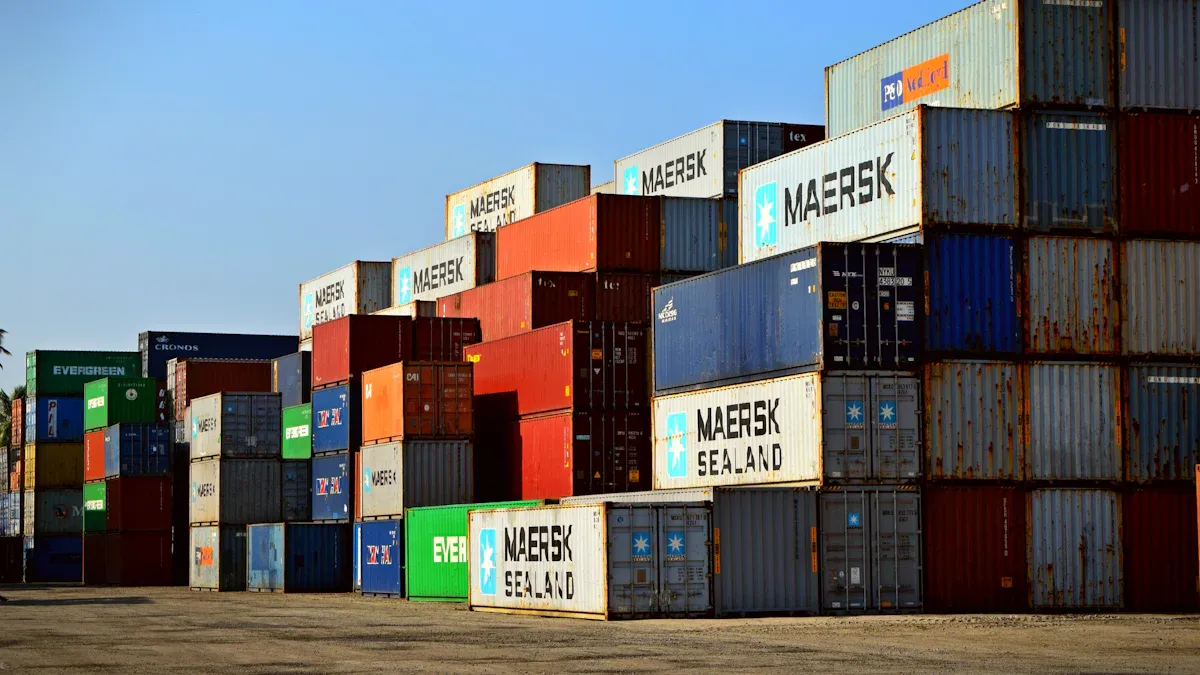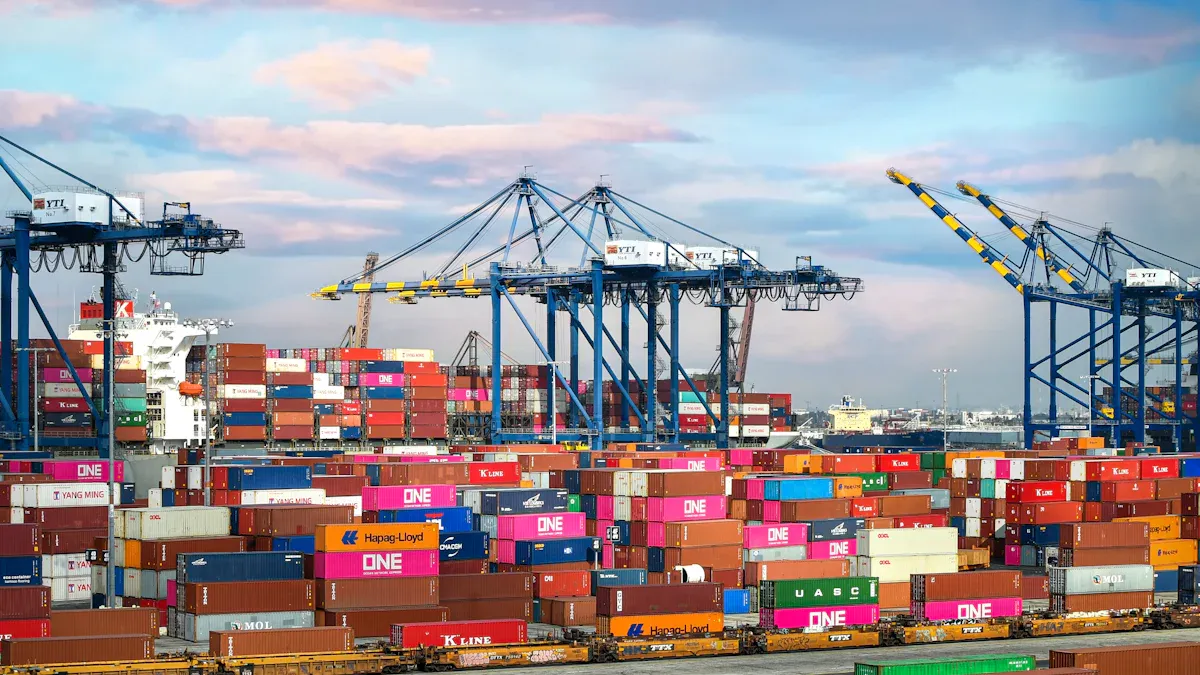Exploring the Different Types of Logistics in 2025

Logistics plays a vital role in supply chain management by ensuring goods move efficiently from suppliers to consumers, with a strong emphasis on supplier management. In 2025, the types of logistics management, including inbound, outbound, reverse, and third-party logistics, will remain crucial for businesses. Recent innovations like AI, IoT, and blockchain have transformed logistics services, enhancing efficiency and supply chain performance. Effective logistics management now focuses on real-time tracking, sustainability, and customer-centric solutions, all of which are integral to effective supplier management. With the global logistics market projected to grow at a 7.2% CAGR, logistics companies must adapt to meet evolving demands and maintain efficiency.
Key Takeaways
Learn about the four key types of logistics: inbound, outbound, reverse, and third-party. Each type helps make supply chains work smoothly.
Use technology like AI, IoT, and blockchain to make logistics better. These tools give live updates and help businesses make smarter choices.
Use eco-friendly methods in logistics to protect the environment. Green logistics can save resources and meet customer needs for sustainability.
Inbound Logistics and Supplier Management
Definition and Purpose of Inbound Logistics
Inbound logistics focuses on managing the transportation, storage, and delivery of goods and materials from suppliers to your business. It ensures that raw materials or components arrive at the right time, in the right quantity, and in good condition. This process is crucial for maintaining production schedules and meeting customer demands. Among the types of logistics management, inbound logistics plays a foundational role by setting the stage for efficient operations downstream.
In 2025, the challenges in inbound logistics have grown more complex. You may face issues like shipping inefficiencies, capacity constraints, and quality problems. Balancing supply and demand while avoiding an information vacuum requires robust strategies. Effective inbound logistics ensures your supply chain remains resilient and adaptable to these challenges.
Key Processes in Inbound Logistics
Managing inbound logistics involves several critical steps. These include sourcing reliable suppliers, coordinating transportation, and overseeing warehousing operations. A well-structured inbound logistics strategy typically follows these steps:
Planning: Develop a sourcing and transportation plan.
Sourcing: Select dependable suppliers.
Purchasing: Negotiate agreements with suppliers.
Transportation: Coordinate the movement of goods.
Receiving: Inspect the quality of incoming materials.
Storage: Organize materials in the warehouse for easy access.
Inventory Management: Track stock levels to avoid shortages.
Each step ensures that your business operates smoothly and avoids disruptions caused by missing data or unexpected surges in demand.
JUSDA's Role in Supplier Management and Warehousing Solutions
JUSDA excels in supplier management and warehousing by leveraging advanced technologies like TMS and WMS. These tools provide real-time data, helping you optimize logistics operations and maintain transparency. JUSDA’s global network of warehouses, spanning over 2.5 million square meters, offers tailored solutions for various industries. Whether you need bonded storage, distribution centers, or cleanroom facilities, JUSDA ensures your warehousing needs are met with precision.
Building strong supplier relationships is another cornerstone of JUSDA’s approach. By fostering collaboration and trust, JUSDA helps you anticipate supply chain disruptions and adjust strategies proactively. Their JusLink platform integrates IoT and big data, enabling seamless communication between suppliers and buyers. This level of integration ensures that your inbound logistics processes remain efficient and cost-effective.
Tip: Partnering with a logistics provider like JUSDA can help you overcome common challenges in inbound logistics, such as shipping inefficiencies and storage constraints.
Outbound Logistics and Distribution
Definition and Purpose of Outbound Logistics
Outbound logistics refers to the processes involved in delivering finished goods from your business to customers. It ensures that products reach their destination efficiently, meeting customer expectations for speed and reliability. This type of logistics focuses on activities like order fulfillment, transportation, and distribution. In 2025, outbound logistics plays a critical role in maintaining customer satisfaction and loyalty, especially as demand for faster and more customized delivery solutions grows.
Key Processes in Outbound Logistics
Managing outbound logistics involves several essential steps to ensure smooth operations. These include:
Order Processing: Confirming and preparing customer orders for shipment.
Inventory Management: Ensuring stock availability to meet demand.
Transportation Planning: Selecting the best routes and modes of transport.
Delivery Execution: Dispatching goods and monitoring their progress.
Customer Communication: Keeping customers informed about delivery status.
You can optimize these processes by adopting real-time tracking technology and predictive intelligence. These tools help you avoid delays, improve decision-making, and customize logistics solutions based on your business needs.
JUSDA's Warehousing and Distribution Capabilities
JUSDA offers comprehensive warehousing and distribution solutions tailored to your business requirements. With over 2.5 million square meters of global warehousing space, JUSDA supports various industries with services like bonded storage, distribution centers, and cleanroom facilities. Their advanced systems, such as JusLink, provide real-time inventory tracking and seamless integration with transportation networks.
To enhance outbound logistics, JUSDA employs strategies like hub-and-spoke and milk run delivery models. For example:
Strategy | Example Scenario | Benefits |
|---|---|---|
Point-to-Point Delivery | An ecommerce retailer shipping small, high-value packages directly to customers. | Faster deliveries with fewer stops, reduced handling, ideal for high-priority shipping needs. |
Hub-and-Spoke | A retail chain delivering inventory to stores across a region. | Lower shipping costs due to bulk consolidation, simplified inventory management, scalability. |
Milk Run Delivery | Shipping components to a manufacturer for final assembly. | Efficient use of transportation resources, lower fuel and labor costs, ideal for short-distance deliveries. |
JUSDA’s focus on automation and multimodal transportation ensures cost-effective and sustainable logistics solutions. By leveraging AI and predictive analytics, JUSDA helps you streamline operations and meet the growing demand for customer-centric logistics.
Tip: Partnering with JUSDA can help you overcome challenges like rising shipping costs and limited warehouse availability, ensuring your outbound logistics remain efficient and competitive.
Reverse Logistics and Sustainability

Definition and Purpose of Reverse Logistics
Reverse logistics focuses on the movement of goods from customers back to businesses. This process includes returns, repairs, recycling, and disposal. It ensures that products are reused, refurbished, or disposed of responsibly. By managing returns effectively, you can reduce waste and recover value from returned items. In 2025, reverse logistics has become a vital part of supply chain management, addressing the growing demand for sustainable practices.
Closed-loop supply chains involve the recovery and reuse of materials and products instead of disposal. This approach not only reduces waste but also minimizes the environmental footprint of businesses.
Key Processes in Reverse Logistics
Managing reverse logistics requires a structured approach to ensure efficiency. Key processes include:
Returns Management: Handling customer returns and ensuring proper inspection.
Refurbishment and Repair: Restoring products to a usable condition.
Recycling and Disposal: Breaking down materials for reuse or safe disposal.
Inventory Recovery: Reintegration of returned items into stock.
These processes help you minimize costs and improve customer satisfaction. Metrics like return rate, processing time, and environmental impact measure the success of reverse logistics.
Metric | Description |
|---|---|
Return Rate | Percentage of products returned relative to total sales. |
Environmental Impact | Metrics on waste reduction or recycling from returns. |
Inventory Recovery Rate | Proportion of returned items successfully reintegrated into inventory. |
Green Logistics Trends in 2025
Green logistics emphasizes sustainability by reducing the environmental impact of supply chain operations. In 2025, reverse logistics plays a key role in green logistics through:
Extending product life cycles by reusing materials.
Encouraging closed-loop supply chains to minimize resource consumption.
Consumer products generate approximately $3 trillion in waste annually. By adopting green logistics practices, you can significantly reduce this waste and contribute to a more sustainable future. Partnering with third-party logistics providers and leveraging technology further enhances your ability to implement sustainable reverse logistics strategies.
Third-Party Logistics (3PL) and JUSDA's Global Network
Definition and Purpose of 3PL
Third-party logistics (3PL) involves outsourcing logistics operations to specialized providers. These companies handle tasks like transportation, warehousing, and order fulfillment, allowing you to focus on your core business activities. By leveraging their expertise, 3PL providers streamline supply chain processes and improve efficiency. In 2025, the demand for third-party logistics continues to grow as businesses seek scalable and cost-effective solutions to meet evolving customer expectations.
The global 3PL market has seen remarkable growth over the past decade. It is projected to reach $1.3 trillion by 2024, driven by advancements in warehouse automation, IoT, and data analytics. These technologies enable 3PL providers to adapt to changing consumer demands and overcome supply chain challenges effectively.
Benefits of Using 3PL Providers
Partnering with a 3PL provider offers several advantages that enhance your logistics operations:
Cost Efficiency: 3PL firms optimize transportation routes and leverage economies of scale to reduce costs.
Customer Experience: Improved delivery reliability and clear communication enhance customer satisfaction.
Scalability: Efficient warehousing and inventory tracking ensure your products are available when needed.
Additionally, 3PL providers bring specialized knowledge in logistics and compliance. They help you expand into new markets with services like cross-border shipping and customs clearance. By outsourcing logistics, you can focus on product development and strategic growth.
JUSDA's Global Warehousing and Transportation Services
JUSDA stands out as a leading 3PL provider with a robust global network. With over 2.5 million square meters of warehousing space across multiple regions, JUSDA offers tailored solutions for industries like electronics, automotive, and FMCG. Their advanced systems, such as JusLink, provide real-time inventory tracking and seamless integration with transportation networks.
JUSDA’s warehousing services include bonded storage, distribution centers, and cleanroom facilities. These facilities ensure efficient order fulfillment and inventory management. Their transportation solutions span air, land, sea, and rail, offering flexibility and reliability for your supply chain needs. By leveraging AI and predictive analytics, JUSDA enhances delivery accuracy and minimizes delays.
Tip: Partnering with JUSDA can help you overcome challenges like fluctuating demand and last-mile delivery issues, ensuring your logistics operations remain competitive.
Fourth-Party Logistics (4PL) and Integrated Solutions
Definition and Purpose of 4PL
Fourth-party logistics focuses on managing and optimizing your entire supply chain. Unlike other types of logistics management, 4PL providers act as strategic partners, overseeing every aspect of your logistics operations. They integrate resources, technology, and expertise to deliver seamless supply chain solutions. By managing all logistics activities from suppliers to end customers, 4PL providers help you reduce costs and improve efficiency. This approach allows you to focus on strategic goals while leaving the complexities of logistics to the experts.
Transitioning to a 4PL model can transform your supply chain. It enables you to achieve economies of scale by leveraging extensive partner networks. This reduces transportation and warehousing costs while enhancing overall performance. With data-driven solutions, 4PL providers ensure your supply chain remains agile and competitive.
Differences Between 3PL and 4PL
Understanding the differences between third-party logistics (3PL) and fourth-party logistics (4PL) is essential for choosing the right solution. Here’s a comparison:
Aspect | 3PL Services | 4PL Services |
|---|---|---|
Core Competencies | Focus on day-to-day logistics operations | Focus on optimizing the entire supply chain |
Vendor Relationship | Transactional, cost-focused | Strategic, long-term relationship |
Systems and Assets | Often own logistics assets like trucks and warehouses | Typically non-asset based, focusing on expertise |
Costs and Overhead | Reduces logistics costs through partnerships | Aims to reduce overall operational costs and improve performance |
While 3PL providers handle specific logistics tasks, 4PL providers take a holistic approach. They act as a single point of contact, ensuring all logistics processes align with your business objectives.
JUSDA's JusLink Intelligent Supply Chain Platform
JUSDA’s JusLink platform exemplifies the power of fourth-party logistics. This intelligent supply chain solution integrates IoT, cloud computing, and big data to provide real-time visibility and collaboration. JusLink connects all stakeholders, from suppliers to customers, ensuring seamless communication and efficient operations.
By using JusLink, you can monitor performance metrics, identify inefficiencies, and optimize your supply chain. The platform supports advanced tools like TMS and WMS, enhancing logistics operations and reducing costs. Its data-driven approach ensures transparency and helps you adapt to changing market demands. With JusLink, JUSDA empowers you to achieve a fully integrated and efficient supply chain.
Tip: When transitioning to a 4PL model, focus on building a robust technological infrastructure and selecting a provider with proven expertise.
Emerging Trends in Logistics

Green Logistics and Sustainability Practices
Green logistics has become a cornerstone of modern supply chain management. In 2025, you can adopt several practices to reduce environmental impact and improve efficiency:
Use AI and IoT for route optimization to cut fuel consumption and enhance shipment efficiency.
Transition to circular supply chains by reusing and recycling materials.
Invest in alternative fuels like electricity, hydrogen, and biofuels.
Implement green warehousing powered by solar panels and energy-efficient systems.
Standardize carbon offsetting programs to achieve sustainability goals.
These practices not only reduce emissions but also align your business with consumer demand for eco-friendly solutions.
Technology-Driven Logistics (AI, IoT, Blockchain)
Technology is revolutionizing logistics operations. IoT devices provide real-time data on inventory and environmental conditions, while AI analyzes this data to optimize planning and decision-making. For example, AI can forecast demand, identify bottlenecks, and streamline inventory management. Blockchain enhances transparency by creating secure, unalterable records of product journeys. It also reduces paperwork and speeds up customs clearance. By integrating these technologies, you can improve efficiency and build trust with stakeholders.
Automation and Robotics in 2025
Automation is reshaping logistics with advancements like autonomous mobile robots (AMRs) and collaborative robots (Cobots). AMRs navigate warehouses to handle tasks like order picking, while Cobots work alongside humans to boost productivity. Edge computing enables robots to make real-time decisions, enhancing operational efficiency. These innovations reduce costs and carbon footprints, making logistics more sustainable and reliable.

SMART JusLink
Supply Chain Management Solution
The evolution of logistics in 2025 highlights its critical role in supply chain management. Each type of logistics, from inbound to reverse, ensures smooth operations and customer satisfaction. You must adapt to trends like sustainability and advanced technologies to stay competitive. Businesses can leverage AI, IoT, and blockchain to enhance efficiency and transparency. Prioritizing greener operations and circular economy models will also help meet environmental goals. By exploring innovative solutions like JUSDA’s JusLink platform, you can optimize logistics networks and prepare for future challenges.
Tip: Conduct a sustainability audit, adopt green packaging, and transition to energy-efficient warehousing to align with modern logistics demands.
See Also
Five Leading Logistics Programs You Should Know About
Innovative Logistics Technologies Shaping Our Future Landscape
Get Prepared: Discovering New Transport Tech for Supply Chains
